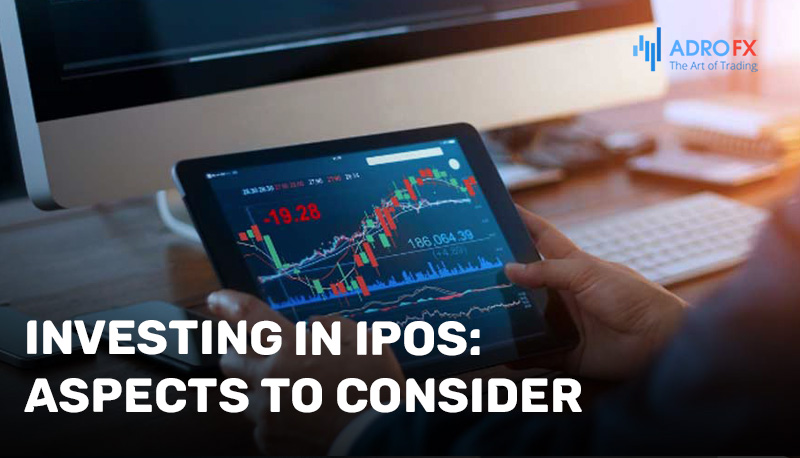Investing in IPOs: Top Things to Know

Initial Public Offerings (IPOs) can be an exciting opportunity for investors to get in on the ground floor of a promising new company. But what exactly is an IPO, and how can investors potentially benefit from it? In this article, we'll take a closer look at what an IPO is, how it works, and some key steps for investing in IPOs.
What Is an IPO and How It Works
An Initial Public Offering (IPO) is the process by which a privately held company offers shares of its stock to the general public for the first time. This process enables the company to raise capital and become publicly traded.
The IPO process typically involves several steps. First, the company hires an investment bank or group of banks to serve as underwriters for the offering. The underwriters help the company determine the initial price of the shares and help to sell the shares to the public.
Next, the company prepares a prospectus, which is a legal document that provides detailed information about the company, including its financials, management team, business strategy, and potential risks. The prospectus is filed with the Securities and Exchange Commission (SEC), which must review and approve the document before the IPO can proceed.
Once the SEC approves the prospectus, the company sets the initial price range for the shares, which is typically based on factors such as the company's financial performance, industry trends, and investor demand. The underwriters then help to market the shares to potential investors, including institutional investors and individual investors.
On the day of the IPO, the company begins trading on a stock exchange, such as the New York Stock Exchange (NYSE) or the NASDAQ. The initial price of the shares is set by the market, based on supply and demand. If there is high demand for the shares, the price may increase above the initial price range, resulting in a significant gain for the company and its investors. However, if there is a low demand for the shares, the price may fall below the initial price range, resulting in a potential loss for investors.
After the IPO, the company is publicly traded, meaning that its shares can be bought and sold by anyone on the stock exchange. The company must comply with various reporting and disclosure requirements, including quarterly and annual financial statements, to provide transparency and accountability to its shareholders.
Why Invest in IPOs?
There are several reasons why investors may choose to invest in IPOs.
First of all, it`s potential for high returns. IPOs can offer significant upside potential, as investors can buy shares at the initial offering price and potentially sell them for a higher price when the stock begins trading on the secondary market.
Secondly, it`s an opportunity to invest in new and growing companies. IPOs often represent new and growing companies that are seeking capital to fund expansion and growth. Investing in these companies can provide exposure to potentially high-growth industries and innovative products or services.
Another crucial reason for investing in IPOs is diversification. It can provide diversification benefits to an investment portfolio, particularly if the IPO is in a sector or industry to which the investor has limited exposure.
Also, it helps access institutional-quality investments. IPOs are often marketed to institutional investors, but individual investors can also participate. This provides individual investors with access to high-quality investment opportunities that they may not otherwise have access to.
And, of course, it is early access to potentially lucrative investments: Investing in IPOs can give investors early access to potentially advantageous investments before they become widely available on the secondary market.

Investing in IPOs: Aspects to Consider
There are several aspects investors should pay attention to before investing in IPOs. They go as follows:
Do your research. Before investing in an IPO, it's important to do your due diligence and research the company thoroughly. This includes looking at the company's financials, management team, business model, industry trends, and potential risks. Investors should also read the prospectus carefully and understand the terms and conditions of the offering.
Consider market trends and sentiment. Investors should consider the broader market trends and sentiment around the IPO. For example, if the market is bullish and there is high demand for IPOs, the price of the shares may be bid up, resulting in a potentially higher price than the company's intrinsic value. Conversely, if the market is bearish, the price of the shares may be lower than expected.
Look at the underwriters. The underwriters of an IPO play a critical role in the success of the offering. Investors can consider investing in the underwriters themselves or other related businesses that may benefit from the IPO.
Consider the lock-up period. After an IPO, there is usually a lock-up period, during which insiders and early investors are prohibited from selling their shares. When the lock-up period expires, there may be a significant amount of selling pressure on the stock, which can lead to a drop in price. Investors should consider the lock-up period when making investment decisions.
Be patient. IPOs can be volatile, and it may take some time for the market to fully recognize the value of a company. Investors should be patient and focus on the long-term potential of the company rather than short-term fluctuations in the stock price.
Diversify your portfolio. As with any investment strategy, it's important to diversify your portfolio and not put all your eggs in one basket. Investing in a mix of IPOs and other stocks, bonds, and assets can help to spread out risk and potentially increase returns over time.
Potential Risks and Drawbacks of Investing in IPOs
Investing in IPOs can come with potential risks and drawbacks, including:
- Lack of historical performance: IPOs are often issued by relatively new companies with limited financial and operating histories. As a result, investors may have limited information on which to base their investment decisions on.
- Volatility: IPOs can be volatile, and the stock price may fluctuate significantly in the first few months or years after the offering. This volatility can be due to factors such as market sentiment, competition, regulatory changes, or unexpected events.
- Limited information: Even after reviewing the prospectus and conducting due diligence, investors may have limited information about the company's prospects, competitive landscape, and potential risks. This lack of information can make it difficult to accurately assess the company's value and make informed investment decisions.
- High valuations: IPOs can be priced at high valuations, which may not be supported by the company's financials or growth potential. If the stock price does not perform as expected, investors may experience significant losses.
- Lock-up periods: As mentioned earlier, IPOs typically have lock-up periods, during which insiders and early investors are prohibited from selling their shares. When the lock-up period expires, there may be a flood of selling pressure on the stock, leading to a drop in price.
- Allocation bias: It can be challenging for individual investors to get allocations of IPO shares, as the majority of shares are typically sold to institutional investors. This can result in an allocation bias, where individual investors may not be able to buy as many shares as they want or at the initial offering price.
- Investors should carefully consider these risks and drawbacks before investing in an IPO and ensure that it aligns with their investment objectives, risk tolerance, and overall portfolio strategy.

Tips to Minimise Risks When Investing in IPOs
Here are some tips that can help investors minimize the risks associated with investing in IPOs:
- Conduct thorough research: Investors should conduct thorough research on the company, its industry, management team, financials, and competitive landscape. Investors can also read the prospectus carefully and understand the terms and conditions of the offering.
- Consider the company's valuation: Investors should assess whether the company's valuation is reasonable based on its financials, growth potential, and competitive landscape. High valuations may not be sustainable in the long term, and investors should be cautious if the company's valuation appears too high.
- Focus on the long-term potential: IPOs can be volatile in the short term, and investors should focus on the long-term potential of the company. Investors should consider the company's growth prospects, competitive advantages, and market share potential.
- Diversify your portfolio: Investors should consider diversifying their portfolios by investing in a mix of IPOs and other stocks, bonds, and assets. This can help to spread out risk and potentially increase returns over time.
- Be patient: IPOs can be volatile, and it may take some time for the market to fully recognize the value of a company. Investors should be patient and focus on the long-term potential of the company rather than short-term fluctuations in the stock price.
- Understand the lock-up period: Investors should understand the lock-up period and consider its potential impact on the stock price. When the lock-up period expires, there may be a significant amount of selling pressure on the stock, which can lead to a drop in price.
- Consider the underwriters: The underwriters of an IPO play a critical role in the success of the offering. Investors can consider investing in the underwriters themselves or other related businesses that may benefit from the IPO.
By following these tips, investors can potentially minimize the risks associated with investing in IPOs and make more informed investment decisions.
Should You Invest in IPOs?
Whether or not to invest in IPOs ultimately depends on an individual's investment objectives, risk tolerance, and overall portfolio strategy. Investing in IPOs can provide investors with an opportunity to invest in new and potentially high-growth companies, but it also comes with potential risks and drawbacks, as discussed earlier.
Investors who are comfortable with the potential risks and have done their due diligence may find investing in IPOs to be a worthwhile addition to their investment portfolio. However, it is essential to consider other factors, such as diversification, and to avoid putting all of their investments in any single stock or sector.
All in all, investing in IPOs can be an excellent way to diversify an investment portfolio and potentially gain exposure to high-growth companies. Still, investors should carefully consider the potential risks and drawbacks associated with investing in IPOs and ensure that it aligns with their investment objectives and overall portfolio strategy.
Conclusion
Overall, investing in IPOs can be a potentially lucrative strategy for investors, but it requires careful research and consideration of the potential risks and rewards. By understanding the basics of what an IPO is and how it works, as well as some key tips for investing in IPOs, investors can be better equipped to take advantage of this exciting opportunity.
About AdroFx
Established in 2018, AdroFx is known for its high technology and its ability to deliver high-quality brokerage services in more than 200 countries around the world. AdroFx makes every effort to keep its customers satisfied and to meet all the trading needs of any trader. With the five types of trading accounts, we have all it takes to fit any traders` needs and styles. The company provides access to 115+ trading instruments, including currencies, metals, stocks, and cryptocurrencies, which make it possible to make the most out of trading on the financial markets. Considering all the above, AdroFx is the perfect variant for anyone who doesn't settle for less than the best.










